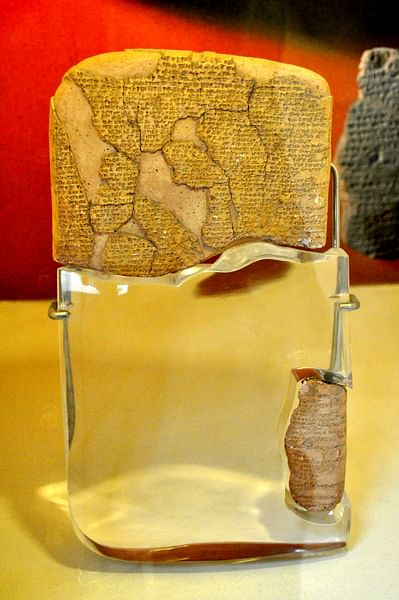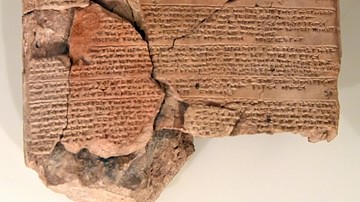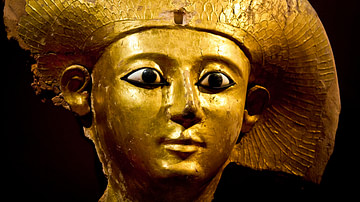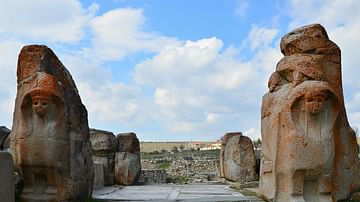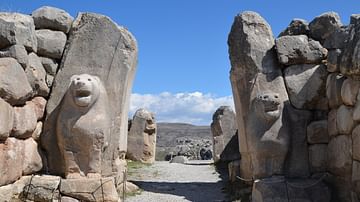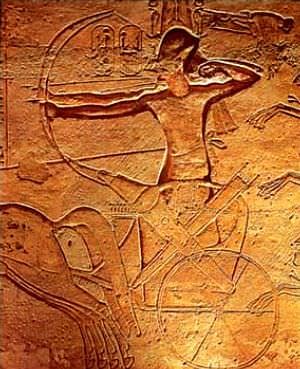
Kadesh was a city in the region of Syria and an important center of trade in the ancient world. It is probably best known as the site of the famous battle between Pharaoh Ramesses II (The Great, 1279-1213 BCE) of Egypt and King Muwatalli II (1295-1272 BCE) of the Hittite Empire in 1274 BCE.
The Battle of Kadesh is the most thoroughly documented military engagement of ancient times in the Middle East with both antagonists claiming a decisive victory. For centuries the account given by Ramesses II in his Poem of Pentaur and Bulletin (the two Egyptian sources we have for the battle) of a great Egyptian victory at Kadesh was taken as literal truth. Today, however, most historians regard these sources as more propaganda than an honest account of the events, and the Battle of Kadesh is believed to have ended in a draw.
Background of the Battle
The Hittites had long been making incursions into Egypt and had caused considerable trouble for the Pharaoh Thutmose III (1458-1425 BCE). Kadesh had been taken and held by the Egyptians under Seti I but the Hittites had reclaimed and fortified it. Ramesses II resolved to take lasting measures against the Hittites and drive them from his borders. A central advantage to be achieved in this campaign was the capture of Kadesh which, as noted, was a great center of commerce at the time. Reclaiming Kadesh would not only give Egypt free access to a hub of trade but would also enlarge the borders of Egypt's empire which had been greatly expanded under Thutmose III.
Ramesses II (or, according to some scholars, his father Seti I) had commissioned a great city to be built in the Eastern Delta which Ramesses II named Per-Ramesses ("House of Ramesses" but also given as "City of Ramesses") which was part pleasure palace and part military-industrial complex. The city had a number of factories manufacturing weapons, training grounds for men, horses, and chariots, and other industries producing necessary supplies for military expeditions.
In 1275 BCE, Ramesses II prepared his army to move and waited only for the interpretation of omens as auspicious to launch his forces. In 1274 BCE, the omens received, he drove his chariot through the gates of Per-Ramesses at the head of over 20,000 men divided into four divisions. He led the Amun division himself with the Re, Ptah, and Set divisions following.
The Battle of Kadesh
In his haste to engage the enemy, Ramesses II drove his division so quickly that he soon outdistanced the rest of his army. He made a further mistake in believing the reports of two captured Bedouins who told him that the Hittite king feared the might of the young pharaoh and had withdrawn from the area.
In reality, the Hittite army was close at hand and, once Ramesses II again began his march, he was ambushed. Two captured Hittite spies then revealed the truth of Ramesses II's situation and the pharaoh understood he had no choice but to fight his way out of the trap he had allowed himself to walk into.
The confusion of the battle is attested to in Ramesses II's accounts, the Poem of Pentaur and the Bulletin in which he relates how the Amun division was overrun by the Hittites and the lines were broken, the division separated. The Hittite cavalry was cutting down the Egyptian infantry and survivors were scrambling for the supposed safety of the Egyptian camp.
Recognizing his situation, Ramesses II called upon his protector god, Amun, and reorganized his forces. Egyptologist Margaret Bunson describes how Ramesses II "brought calm and purpose to his small units and began to slice his way through the enemy in order to reach his southern forces" (131). He held the remains of his meager troops together through the force of his own character and the power of his position as pharaoh and commander-in-chief. Bunson continues:
With only his household troops, with a few officers and followers, and with the rabble of the defeated units standing by, he mounted his chariot and discovered the extent of the forces against him. He then charged the eastern wing of the assembled foe with such ferocity that they gave way, allowing the Egyptians to escape the net which Muwatalli had cast for them. (131)
Ramesses II had turned the tide of battle just as the Ptah division arrived on the field.
The Ptah division, with Ramesses II leading them, then drove the Hittite forces toward the Orontes River where many of them drowned. At this point in the battle, the Egyptian forces were caught between the Hittites at the river and the reserve forces Muwatalli II still had at his disposal in the fortified city of Kadesh. Why the Hittite king did not make use of his advantage is unknown but, for whatever reason, Muwatalli II refused to deploy his forces and "watched the cream of his command fall before Ramesses, including his own brother" (Bunson, 131). Ramesses II pressed his advantage and led his forces in a furious charge.
With the Hittites drowning in the river and being slaughtered on the banks, Ramesses II turned his forces about and, making full use of his advantage in the light Egyptian chariot, drove the Hittites from the field. Ramesses II then claimed a great victory for Egypt in that he had defeated his enemy in battle. Muwatalli II, however, also claimed victory in that he had not lost Kadesh.
Conclusion
The significance of the battle, aside from being the victory Ramesses II seemed most proud of, is that it eventually led to the first peace treaty in the history of the world signed between the Hittite and Egyptian Empires in 1258 BCE. Among the stipulations was that "persons of rank or importance would be returned to their own rulers if they tried to flee from one territory to the other in order to escape punishment for crimes" (Bunson, 87). This meant that countries would cooperate in returning fugitives of noble status instead of assisting them in organizing a coup against a sitting ruler, a common practice in many different civilizations of antiquity.
The Treaty of Kadesh was not only the world's first peace treaty but also the first time on record that such a stipulation was made in any kind of treaty. The much earlier treaty from Mesopotamia in 2550 BCE, often cited today as the world's first peace treaty, and known as The Treaty of Mesilim, is not actually a 'peace treaty' but rather a treaty of delimitation, which marks borders or boundaries instead of agreeing on terms for peace between nations.
The Treaty of Kadesh is recognized as the world's first actual peace treaty and set the stage for relations between Egypt and the Hittites until the fall of the Hittite Empire c. 1200 BCE. Instead of warring with each other, the Egyptians and Hittites opened trade relations and exchanged technological and agricultural expertise which improved the lives of the people of both nations.
